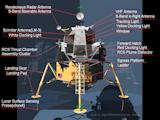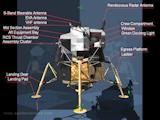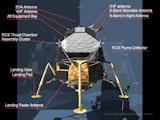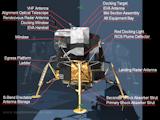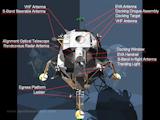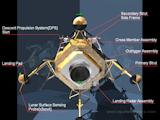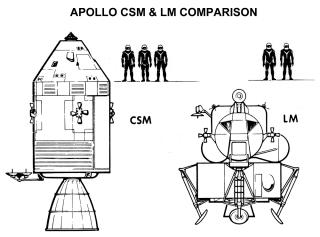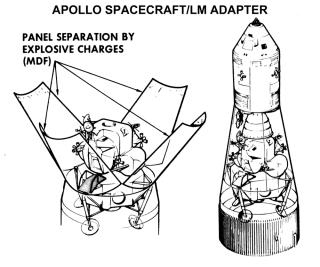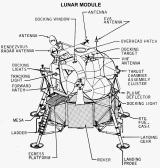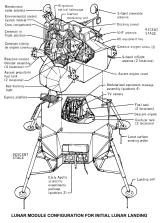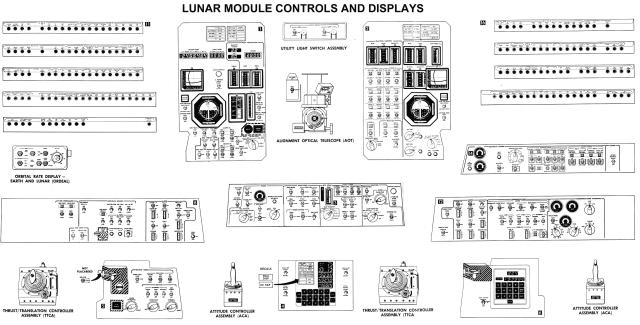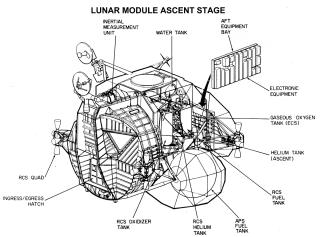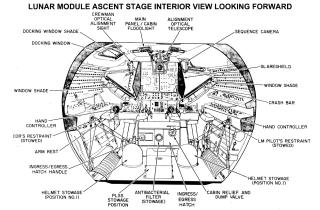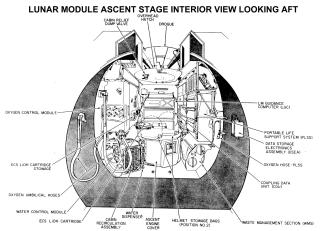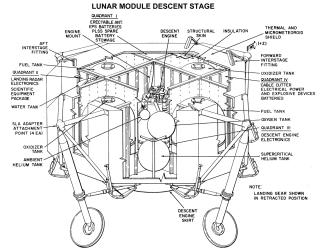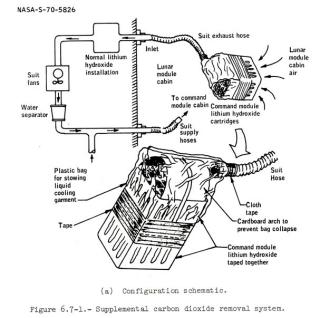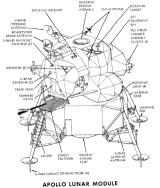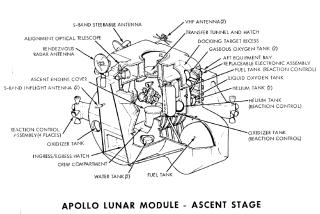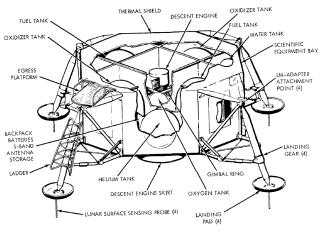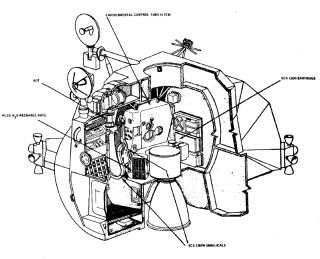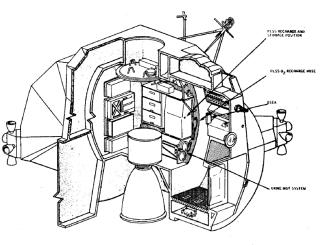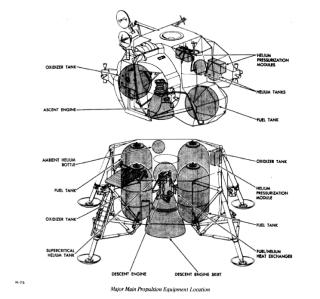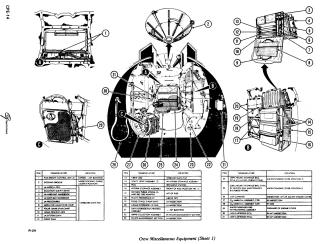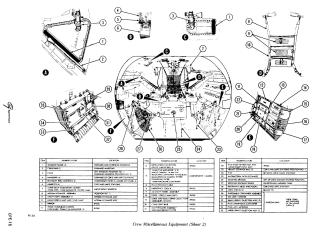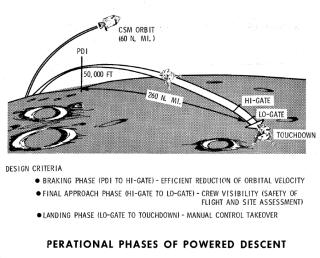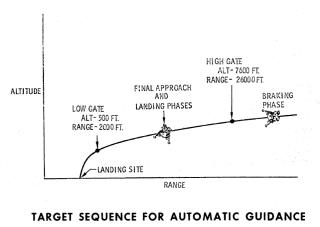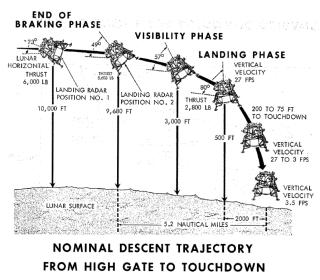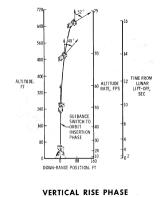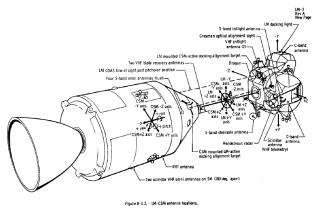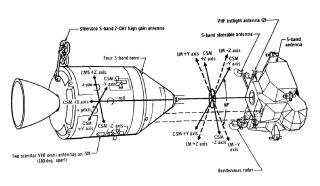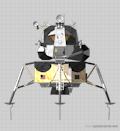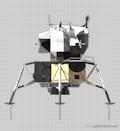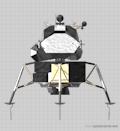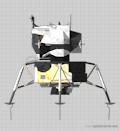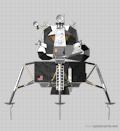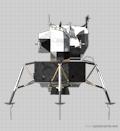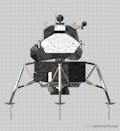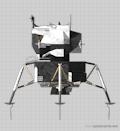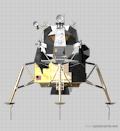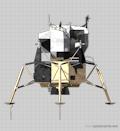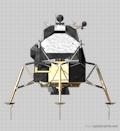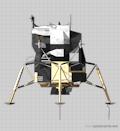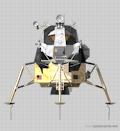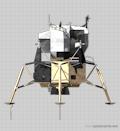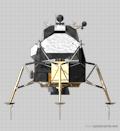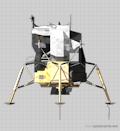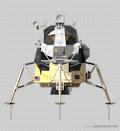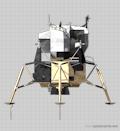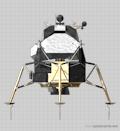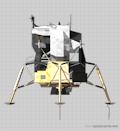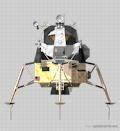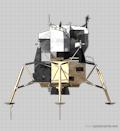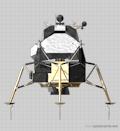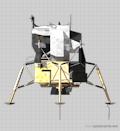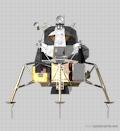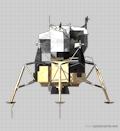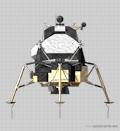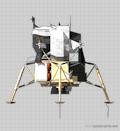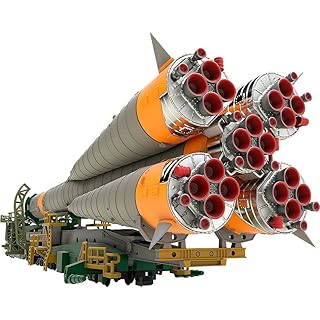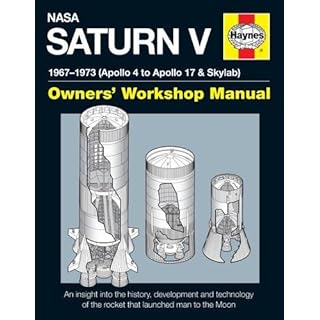月着陸船(LM)
- 高さ:23ft (7.0104m)
- 最大重量:36244lb (16.454ton)
- 製造:グラマン(Grumman Aircraft Engineering Corp., Bethpage, N.Y.)
概要


上昇段(Ascent Stage)

LMはその厳しい重量制限から、徹底的な軽量化が図られており、ほとんどの部分はアルミの骨組みに断熱のための金属箔を張っただけの「ハリボテ」である。


クルーコンパートメントは直径約92インチ(2.3m)、奥行き約42インチ(1m)で、正面に 二つの三角形の窓と月面へ降りるためのハッチ、内部は左側が船長(CDP)、右側が月着陸船パイロット(LMP)のコンソールである。 また船長側の屋根の部分には、小さなドッキング窓がついている。 CDPの左側とLMPの右側には Equipment Storage がある。 CDP側には環境制御装置やバックパック(PLSS:PORTABLE LIFE SUPPORT SYSTEM)のCO2キャニスター、LMP側にはカメラや食料などが格納されている。 床にはベルクロパイルが張られており、無重力状況下で宇宙飛行士の靴を固定することができる。 宇宙空間および月面でしか運用されないため、操縦席に椅子はない。飛行士はケーブルで体をくくりつけるだけで、立ったまま操縦する。 正面のハッチは飛行士が月面に降りるために使用するもので、バックパック(PLSS)を背負ったまま出入りするため、約32インチ四方の四角形となっている。 ヒンジは船内から見て右手についており、LMP側の内側へ開く。与圧中は気圧によって周りのシリコンがぴったりと密封しており、開くにはハッチについているバルブを操作して船内の空気を完全に排気する必要がある。


2つの三角窓とドッキング窓は2層になっている。外層の外側は紫外線などを遮断するため、59層のコーティングがなされている。 また、外層の内側と内層には高効率の反射防止コーティングがなされている。 そして曇り防止の電気ヒーターが備えられているが、温度監視機能はないので、飛行士が常にチェックする必要がある。 すべての窓には遮光板が取り付けられており、使わないときは窓の脇に巻き上げられている。 キャビンの後部は奥行き54インチ、高さ5フィートの楕円形の「ミッドセクション(Mid Section)」である。 ここには、中央に月から飛び立つときに使用する上昇エンジン、右側には環境制御装置、水供給機、月の石を格納するコンテナ、生命維持装置、 左側には廃棄物処理装置、酸素浄化装置、そして食料や月面シューズなどを格納する各種コンテナが取り付けられている。 そして後部隔壁には電源システム(EPS:Electrical Power Subsystem)、 誘導・ナビゲーションシステム(GN&CS:Guidance, Navigation, and Control Subsystem)が搭載されている。

ミッドセクションの上部には、CSMとのドッキングに使用するオーバーヘッドハッチがある。 これは直径33インチの円形で、その構造は正面ハッチと同様であり、内側に開く。

ミッドセクションの後ろは、与圧されていない後部機材隔室(Aft Equipment Bay)である。 ここにはGN&CS, EPS, 通信システムなどの電子機器が搭載されており、グリコールによるcold rails で冷却されている。 また2つの気化酸素タンクと2つの気化ヘリウムタンクもここに取り付けられている。
下降段(Descent Stage)


下降段の筐体は8角形の外観をしており、ここに中央と前後左右に合計5つの四角いエリア、その周りに4つの三角形のエリアがある。 中央のセクションにエンジンが搭載されている。 外周の四角いエリアは前部と後部に酸化剤タンク、左右には燃料タンクを搭載する。 またその間にある三角形のエリアを上から見て反時計回りにquad No.1, 2, 3, 4と呼ぶ。 quad No.1には折り畳み式S-バンドアンテナとバッテリーが搭載されている。 さらにJミッションでは月面車(LRV:Lunar Roving Vehicle)も折り畳んで搭載される。 quad No.2には水タンク、着陸レーダー機器、科学観測機器、原子力発電器が搭載されている。 quad No.3には酸素タンクとヘリウムタンク、月面探査用各種機材が搭載されている。 quad No.4にはバッテリーと、飛行士が月に降り立つ様子を撮影するカメラなどが搭載された、 modularized equipment stowage assembly (MESA)が組み込まれている。

LM全体は、金色、銀色もしくは黒色のシートのようなもので包まれている。 これは耐熱および微小隕石から機体を保護するシートである。 これらはThermal Blanketと呼ばれ、主にアルミニウムまたはインコネルとニッケルのフォイル、そしてマイラーとH-film blanketと呼ばれる特殊なシートを何層にも重ねたものである。 このシートの張り方はミッションによって異なっており、このためLMのカラーリングもミッションごとに微妙に変わることとなった。
LM COLOR CHART
| LM-3 Apollo9 Spider |
|---|
| 脚にはThermal Blanketはなくアルミ地むき出し。月面センサーは4つの脚全てにある。正面にシミターアンテナ。RCS Plume Deflectorなし。 |
| LM-4 Apollo10 Snoopy |
|---|
| 脚にはThermal Blanketはなくアルミ地むき出し。月面センサーは4つの脚全てにある。RCS Plume Deflectorなし。 |
| LM-5 Apollo11 Eagle |
|---|
| 月面センサーは3つの脚にある。RCS Plume Deflectorが追加された。 |
| LM-6 Apollo12 Intrepid |
|---|
| 下降段のQuad2に原子力電池が搭載された。 |
| LM-7 Apollo13 Aquarius |
|---|
| 仕様はLM6とほぼ同じ。 |
| LM-8 Apollo14 Antares |
|---|
| 下降段のカラーリングが大幅に変更。 |
| LM-10 Apollo15 Falcon |
|---|
| Jミッションバージョン。Quad1に月面車を搭載。 |
| LM-11 Apollo16 Orion |
|---|
| 仕様はLM10とほぼ同じ。 |
| LM-12 Apollo17 Challenger |
|---|
| 仕様はLM10とほぼ同じ。 |
関連書籍・ビデオ
-
月着陸船開発物語

プレアデス出版 2019-02-01 2,700円
洋書Moon Lander: How We Developed the Apollo Lunar Moduleの翻訳。 当時の最先端技術を結集させたアポロ計画の中でも月着陸船の開発は困難を極めた。巨大なサターン・ロケットや司令船は、それまでのマーキュリー計画、ジェミニ計画で培った技術の発展型、応用版ともいえるものであるが、月着陸船の開発はそれまでどこにもなかったもので、まさにゼロからのスタートであった。しかも、度重なる仕様変更や重量軽減、さらにコスト、時間との闘いに苦しめられた。本書は“月着陸船の父”と呼ばれ、最盛期3,000人余の開発チームを率いたグラマン社の若きチーフエンジニアが完成までの全工程を詳細に書き記したメモワール。
-
Apollo Spacecraft - News Reference

Periscope Film LLC / ApogeeBooks 2005/11/26 USD60.00
NASAが発行したApollo Spacecraft News Referenceの復刻版です。 詳しい構造説明だけでなく、他では見られない貴重な写真や図版も豊富。 設計者によるアポロ宇宙船(CSM)と月着陸船(LM)のハードウェアに関する詳細な説明が500ページにわたって書かれているマニュアルで、 本物はオークションで $6,000を超える金額で取り引きされています。 このレプリカは、表紙も全てのページもオリジナルそのまま。 さらにLMの開発記録映像と静止画を大量に格納したDVDディスクが付いてUSD60.00です。 長らく出版社であるApogee Booksからの直販だけでしか購入できませんでしたが、2011年6月より一般書店でも扱われるようになりました。
-
Lunar Module LM 10 Thru LM 14 Vehicle Familiarization Manual

Periscope Film LLC 2013/01/01 USD18.05
Originally created for NASA in 1969 by prime contractor Grumman, this Lunar Module Vehicle Familiarization Manual was mandatory reading for Apollo astronauts, contractors and NASA support staff. This version of the manual describes the so-called ELM, or Extended Lunar Modules designed for the "J"class missions Apollo 15-17 and the never-flown Apollo 18 and 19. The ELM came about as part of NASA's efforts to enhance the scientific study of the Moon and its geology. To do that, longer surface stays would be needed. To make it possible, LM 10 to LM 14 received various modifications intended to increase their payloads, and allow them to return larger samples to Earth.
-
LEM Lunar Excursion Module Familiarization Manual

Periscope Film LLC 2011/03/09 USD15.40
Designed by Grumman's brilliant Tom Kelly, the Apollo Lunar Excursion Module (or "LEM" for short) was a triumph of purpose-built engineering. In the six years 1962-1968 between drawing board and first flight, a myriad of challenges were overcome related to weight, reliability and safety. The final design, designated the Lunar Module or "LM", boasted tiny windows instead of large portholes, four legs instead of five and most famously had no seats ― instead relying on the astronauts' legs to cushion a lunar landing.
-
Haynes Nasa Mission AS-506 Apollo 11 Owners' Workshop Manual: 1969 (Including Saturn V, CM-107, SM-107, LM-5)

Haynes Publishing 2009/12/01 USD32.95
アポロ計画とアポロ11号を紹介するムック。 全ページカラーで、写真、図面も多く眺めるだけでも楽しめます。 米ソの宇宙開発レースからアポロ計画の全貌、サターンV、アポロ宇宙船、コンピューター、宇宙服、通信など、 アポロに関わるメカが当時の写真とともに詳しく解説されています。
-
VIRTUAL LM: A Pictoral Essay Of The Engineering And Construction Of The Apollo Lunar Module

Scott P. Sullivan / Apogee Books Space Series 2004/07/31 JPY3,118
The Apollo Lunar Module is revealed in this book to be both an engineering masterpiece and a work of art.
-
Building Moonships : The Grumman Lunar Module

Joshua Stoff / Arcadia Publishing 2004/04/24 JPY2,461
In 1961, after the United States had acquired a total of fifteen minutes of spaceflight experience, President John F. Kennedy announced his plans for landing a man on the moon by 1970. The space race had begun. In 1962, after a strenuous competition, the National Aeronautics and Space Administration (NASA) announced that the Grumman Aircraft Engineering Corporation of Bethpage, Long Island, had won the contract to build the lunar module-the spacecraft that would take Americans to the moon. This was the first, and the only, vehicle designed to take humans from one world to another.
-
Moon Lander: How We Developed the Apollo Lunar Module

Thomas J. Kelly / Smithsonian Inst Pr 2001/03/01 JPY2872
Chief engineer Thomas J. Kelly gives a firsthand account of designing, building, testing, and flying the Apollo lunar module. It was, he writes, “an aerospace engineer’s dream job of the century.” Kelly’s account begins with the imaginative process of sketching solutions to a host of technical challenges with an emphasis on safety, reliability, and maintainability. He catalogs numerous test failures, including propulsion-system leaks, ascent-engine instability, stress corrosion of the aluminum alloy parts, and battery problems, as well as their fixes under the ever-present constraints of budget and schedule.




